A Review and Bibliometric Analysis on Applications of Microbial Degradation of Hydrocarbon Contaminants in Arctic Marine Environment at Metagenomic and Enzymatic Levels
Abstract
1. Introduction
2. Application of Microbial Community in Biodegradation of Hydrocarbons in Arctic and Antarctic Marine Environments: Comparative Bibliometric Analysis and Literature Review
2.1. Keyword Co-Occurrence Analysis
2.2. Trends of Publications in the Last 10 Years
2.3. Analysis of Publications in Subject Areas
2.4. Global Output in Publications and Most Progressive Affiliations
2.5. Source Journals Trends, Most Cited Articles Based on Journal Ranks, and Relevance to the Field
2.6. Most Prolific Authors
2.7. Limitations of Bibliometric Study
3. Consequences of Hydrocarbon Pollution in Arctic Environments: Seawater, Marine Sediments, and Coastal Environments
3.1. Seawater of the Marine Environment
3.2. Marine Sediment
3.3. Coastal or Shoreline of Arctic Ocean
3.4. Toxicological Effects of Hydrocarbon Pollution on Different Marine Environments.
4. Application of Microbial Community in Biodegradation of Hydrocarbons in Arctic Environments
5. Metabolic Pathways of Oil-Degrading Microbial Community at the Enzymatic Level
6. Microbial Degradation Capacity at the Metagenomic Level
7. Future Prospects of Bioremediation in the Arctic: Limitations and Suggestions
8. Conclusions
Author Contributions
Funding
Acknowledgments
Conflicts of Interest
References
- Klein, D. Organic Chemistry, 3rd ed.; John Wiley and Sons, Inc.: Hoboken, NJ, USA, 2017; Volume 51, p. 132. [Google Scholar]
- Speight, J.G. Handbook of Petroleum Refining; CRC Press, Taylor & Francis Group: Boca Raton, FL, USA, 2019. [Google Scholar]
- Arctic Council. Heavy Fuel Oil (HFO) Use by Ships in the Arctic 2019; Arctic Council: Tromsø, Norway, 2020. [Google Scholar]
- Decola, E.; Robertson, T.; Fisher, M.; Blair, L. Phasing Out the Use and Carriage for Use of Heavy Fuel Oil in the Canadian Arctic: Impacts to Northern Communities; Nuka Research and Planning Group LLC.: Plymouth, MA, USA; Northern Economics: Anchorage, AK, USA, 2018. [Google Scholar]
- Comer, B.; Olmer, N.; Mao, X.; Roy, B.; Rutherford, D. Prevalence of Heavy Fuel Oil and Black Carbon in Arctic Shipping, 2015 to 2025; International Council on Clean Transportation: San Francisco, CA, USA, 2017. [Google Scholar]
- Deggim, H. The International Code for Ships Operating in Polar Waters (Polar Code); Springer: Berlin/Heidelberg, Germany, 2018. [Google Scholar] [CrossRef]
- Wang, C.; Liu, X.; Guo, J.; Lv, Y.; Li, Y. Biodegradation of marine oil spill residues using aboriginal bacterial consortium based on Penglai 19-3 oil spill accident, China. Ecotoxicol. Environ. Saf. 2018, 159, 20–27. [Google Scholar] [CrossRef] [PubMed]
- Peterson, C.H.; Rice, S.D.; Short, J.W.; Esler, D.; Bodkin, J.L.; Ballachey, B.E.; Irons, D.B. Long-term ecosystem response to the Exxon Valdez oil spill. Science 2003, 302, 2082–2086. [Google Scholar] [CrossRef]
- Kozhukhova, E.; Litvinova, M.; Makarevich, E.; Malaeva, A. Biodegradation of petroleum hydrocarbons by bioflocculant-producing microorganisms of the aquatic ecosystems in the Arctic region. IOP Conf. Ser. Earth Environ. Sci. 2020, 539, 012192. [Google Scholar] [CrossRef]
- Nath, S.; Deb, B.; Sharma, I. Isolation and characterization of cadmium and lead resistant bacteria. Glob. Adv. Res. J. Microbiol. 2012, 1, 194–198. [Google Scholar]
- Solis, B.P.; Argüello, J.C.C.; Barba, L.G.; Gurrola, M.P.; Zarhri, Z.; TrejoArroyo, D.L. Bibliometric Analysis of the Mass Transport in a Gas Diffusion Layer in PEM Fuel Cells. Sustainability 2019, 11, 6682. [Google Scholar] [CrossRef]
- Mingers, J.; Leydesdorff, L. A Review of Theory and Practice in Scientometrics. Eur. J. Oper. Res. 2015, 1–19. [Google Scholar] [CrossRef]
- Vasconcelos, R.N.; Lima, A.T.C.; Lentini, C.A.D.; Miranda, G.V.; Mendonça, L.F.; Silva, M.A.; Cambuí, E.C.B.; Lopes, J.M.; Porsani, M.J. Oil Spill Detection and Mapping: A 50-Year Bibliometric Analysis. Remote Sens. 2020, 12, 3647. [Google Scholar] [CrossRef]
- Gläser, J.; Laudel, G. A bibliometric reconstruction of research trails for qualitative investigations of scientific innovations. Hist. Soc. Res. Hist. Sozialforch. 2015, 40, 299–330. [Google Scholar]
- Tsay, M.Y. A bibliometric analysis of hydrogen energy literature, 1965-2005. Scientometrics 2008, 75, 421–438. [Google Scholar] [CrossRef]
- Campbell, D.; Picard-Aitken, M.; Côté, G.; Macaluso, B.Î.; Robitaille, J.P.; Bastien, N.; Laframboise, M.C.; Lebeau, L.M.; Mirabel, P.; Larivière, V.; et al. Bibliometrics as a performance measurement tool for research evaluation: The case of research funded by the national cancer institute of Canada. Proc. ISSI 2009, 301–312. [Google Scholar] [CrossRef]
- Scopus. Available online: https://www.scopus.com/ (accessed on 19 November 2020).
- Ki Kiduk, Y.; Meho, L.I. Citation analysis: A comparison of Google Scholar, Scopus, and Web of Science. Proc. ASIST Annu. Meet. 2006, 43. [Google Scholar] [CrossRef]
- Elsevier. Scopus: Content Coverage Guide; Elsevier: Amsterdam, The Netherlands, 2020. [Google Scholar]
- Borthakur, A.; Govind, M. Public Understandings of E-Waste and Its Disposal in Urban India: From a Review towards a Conceptual Framework. J. Clean. Prod. 2018, 1053–1066. [Google Scholar] [CrossRef]
- Herrera-Viedma, E.; Martinez, M.A.; Herrera, M. Bibliometric tools for discovering information in database. In Trends in Applied Knowledge-Based Systems and Data Science IEA/AIE 2016. Lecture Notes in Computer Science; Fujita, H., Ali, M., Selamat, A., Sasaki, J., Kurematsu, M., Eds.; Springer: Cham, Switzerland, 2016; p. 9799. [Google Scholar]
- Md Khudzari, J.; Kurian, J.; Tartakovsky, B.; Raghavan, G.S.V. Bibliometric analysis of global research trends on microbial fuel cells using Scopus database. Biochem. Eng. J. 2018, 136, 51–60. [Google Scholar] [CrossRef]
- Medina-Bellver, J.I.; Marín, P.; Delgado, A.; Rodríguez-Sánchez, A.; Reyes, E.; Ramos, J.L.; Marqués, S. Evidence for in situ crude oil biodegradation after the Prestige oil spill. Environ. Microbiol. 2005, 7, 773–779. [Google Scholar] [CrossRef]
- Leahy, J.G.; Colwell, R.R. Microbial degradation of hydrocarbons in the environment. Microbiol. Mol. Biol. 1990, 54, 305–315. [Google Scholar] [CrossRef]
- Das, N.; Chandran, P. Microbial degradation of petroleum hydrocarbon contaminants: An overview. Biotechnol. Res. Int. 2011, 2011, 1–13. [Google Scholar] [CrossRef] [PubMed]
- Wilkinson, J.; Beegle-Krause, C.J.; Evers, K.-U.; Hughes, N.; Lewis, A.; Reed, M.; Wadhams, P. Oil spill response capabilities and technologies for ice-covered Arctic marine waters: A review of recent developments and established practices. Ambio 2017, 46, 423–441. [Google Scholar] [CrossRef] [PubMed]
- Hidalgo, K.J.; Sierra-Garcia, I.N.; Dellagnezze, B.M.; de Oliveira, V.M. Metagenomic insights into the mechanisms for biodegradation of polycyclic aromatic hydrocarbons in the oil supply chain. Front. Microbiol. 2020, 11. [Google Scholar] [CrossRef]
- Larivière, V.; Haustein, S.; Mongeon, P. The Oligopoly of Academic Publishers in the Digital Era. PLoS ONE 2015, 10, 1–15. [Google Scholar] [CrossRef]
- Grech, V.; Rizk, D.E.E. Increasing importance of research metrics: Journal Impact Factor and h-index. Int. Urogynecol. J. 2018, 29, 619–620. [Google Scholar] [CrossRef]
- Abad-Segura, E.; Morales, M.E.; Cortés-García, F.J.; Belmonte-Ureña, L.J. Industrial Processes Management for a Sustainable Society: Global Research Analysis. Processes 2020, 8, 631. [Google Scholar] [CrossRef]
- Zhang, Y.; Guo, Y.; Wang, X.; Zhu, D.; Porter, A.L. A Hybrid Visualisation Model for Technology Roadmapping: Bibliometrics, Qualitative Methodology and Empirical Study. Technol. Anal. Strateg. Manag. 2013, 25, 707–724. [Google Scholar] [CrossRef]
- Costa, S.; Caldeira, R. Bibliometric Analysis of Ocean Literacy: An Underrated Term in the Scientific Literature. Mar. Policy 2018, 87, 149–157. [Google Scholar] [CrossRef]
- Lan, D.; Liang, B.; Bao, C.; Ma, M.; Xu, Y.; Yu, C. Marine Oil Spill Risk Mapping for Accidental Pollution and Its Application in a Coastal City. Mar. Pollut. Bull. 2015, 96, 220–225. [Google Scholar] [CrossRef]
- Duran, R.; Cravo-Laureau, C. Role of environmental factors and microorganisms in determining the fate of polycyclic aromatic hydrocarbons in the marine environment. FEMS Microbiol. Rev. 2016, 40, 814–830. [Google Scholar] [CrossRef] [PubMed]
- Neethu, C.S.; Saravanakumar, C.; Purvaja, R.; Robin, R.S.; Ramesh, R. Oil-spill triggered shift in indigenous microbial structure and functional dynamics in different marine environmental matrices. Sci. Rep. 2019, 9, 1–13. [Google Scholar] [CrossRef]
- Xue, J.; Yu, Y.; Bai, Y.; Wang, L.; Wu, Y. Marine oil-degrading microorganisms and biodegradation process of petroleum hydrocarbon in marine environments: A review. Curr. Microbiol. 2015, 71, 220–228. [Google Scholar] [CrossRef]
- NCA. Kystverkets beredskap mot akutt forurensning. In Årsrapport 2012; NCA Preparedness for Acute Pollution. Annual Report 2012; Norwegian Coastal Administration (NCA): Ålesund, Norway, 2013; pp. 1–20. (In Norwegian) [Google Scholar]
- CBC News. Trans Mountain Pipeline Spill in Abbotsford Estimated at up to 190,000 Litres of Crude Oil. Available online: https://www.cbc.ca/news/canada/british-columbia/trans-mountain-pipeline-spill-abbotsford-150000-190000-litres-1.5611973 (accessed on 1 November 2020).
- The New York Times. Russia Declares Emergency After Arctic Oil Spill. Available online: https://www.nytimes.com/2020/06/04/world/europe/russia-oil-spill-arctic.html (accessed on 1 November 2020).
- Independent. Tanker Spills over 4000 Gallons of Crude Oil into Cuyama River. Available online: https://www.independent.com/2020/03/24/tanker-spills-over-4000-gallons-of-crude-oil-into-cuyama-river/ (accessed on 1 November 2020).
- Electrek. EGEB: Keystone Oil Spill in North Dakota, US Green Energy Grows by 6.15% to Date, More. Available online: https://electrek.co/2019/11/01/egeb-keystone-pipeline-oil-spill-north-dakota-us-green-energy-grows/ (accessed on 1 November 2020).
- Huffpost. Newfoundland Oil Spill Now Impossible to Clean Up: Watchdog. Available online: https://www.huffingtonpost.ca/2018/11/20/newfoundland-oil-spill-impossible-clean_a_23595116/ (accessed on 1 November 2020).
- CBC News. Trans Mountain Pipeline Spill in Abbotsford Estimated at up to 190,000 Litres of Crude Oil. Available online: https://www.cbc.ca/news/business/pipeline-leak-fouls-creek-near-grizzly-bear-protection-area-in-northwestern-alberta-1.3634989 (accessed on 1 November 2020).
- Fingas, M.F.; Hollebone, B.P. Review of behaviour of oil in freezing environment. Mar. Pollut. Bull. 2003, 47, 333–340. [Google Scholar] [CrossRef]
- Montagnolli, R.; Lopes, P.; Bidoia, E. Screening the toxicity and biodegradability of petroleum hydrocarbons by a rapid colorimetric method. Arch. Environ. Contam. Toxicol. 2015, 68, 342–353. [Google Scholar] [CrossRef] [PubMed]
- Bargiela, R.; Yakimov, M.M.; Golyshin, P.N. Consequences of Microbial Interactions with Hydrocarbons, Oils, and Lipids: Production of Fuels and Chemicals; Springer: Berlin/Heidelberg, Germany, 2017; pp. 629–651. [Google Scholar]
- Friedman, C.L.; Selin, N.E. Long-range atmospheric transport of polycyclic aromatic hydrocarbons: A global 3-D model analysis including evaluation of Arctic sources. Environ. Sci.Technol. 2012, 46, 9501–9510. [Google Scholar] [CrossRef] [PubMed]
- Bakke, T.; Klungsøyr, J.; Sanni, S. Environmental impacts of produced water and drilling waste discharges from Norwegian offshore petroleum industry. Mar. Environ. Res. 2013, 92, 154–169. [Google Scholar] [CrossRef] [PubMed]
- Abdel-Shafy, H.I.; Mansour, M.S.M. A review on polycyclic aromatic hydrocarbons: Source, environmental impact, effect on human health and remediation. Egypt. J. Pet. 2016, 25, 107–123. [Google Scholar] [CrossRef]
- Cerniglia, C.E.; Heitkamp, M.A. Polycyclic aromatic hydrocarbon degradation by Mycobacterium. Meth. Enzymol. 1990, 188, 148–153. [Google Scholar]
- DeGraeve, G.M.; Elder, R.G.; Woods, D.C.; Bergman, H.L. Effects of naphthalene and benzene on fathead minnows and rainbow trout. Arch. Environ. Contam. Toxicol. 1982, 11, 487–490. [Google Scholar] [CrossRef]
- Teles, M.; Pacheco, M.; Santos, M.A. Anguilla anguilla L. liver ethoxyresorufin O-deethylation, glutathione S-transferase, erythrocytic nuclear abnormalities, and endocrine responses to naphthalene and b-naphthoflavone. Ecotoxicol. Environ. Saf. 2003, 55, 98–107. [Google Scholar] [CrossRef]
- Fossi, M.; Pedà, C.; Compa, M.; Tsangaris, C.; Alomar, C.; Claro, F.; Ioakeimidis, C.; Galgani, F.; Hema, T.; Deudero, S.; et al. Bioindicators for monitoring marine litter ingestion and its impacts on Mediterranean biodiversity. Environ. Pollut. 2018, 237, 1023–1040. [Google Scholar] [CrossRef]
- Milinkovitch, T.; Geraudie, P.; Camus, L.; Huet, V.; Thomas-Guyon, H. Biomarker modulation associated with marine diesel contamination in the Iceland scallop (Chlamys islandica). Environ. Sci. Pollut. Res. 2015, 22, 19292–19296. [Google Scholar] [CrossRef]
- Geraudie, P.; Bakkemo, R.; Milinkovitch, T.; Thomas-Guyon, H. First evidence of marine diesel effects on biomarker responses in the Icelandic scallops, Chlamys islandica. Environ. Sci. Pollut. Res. 2016, 23, 16504–16512. [Google Scholar] [CrossRef] [PubMed]
- Sagerup, K.; Nahrgang, J.; Frantzen, M.; Larsen, L.-H.; Geraudie, P. Biological effects of marine diesel oil exposure in red king crab (Paralithodes camtschaticus) assessed through a water and foodborne exposure experiment. Mar. Environ. Res. 2016, 119, 126–135. [Google Scholar] [CrossRef]
- Wilson, J.Y.; Cooke, S.R.; Moore, M.J.; Martineau, D.; Mikaelian, I.; Metner, D.A.; Lockhart, W.L.; Stegeman, J.J. Systemic effects of Arctic pollutants in beluga whales indicated by CYP1A1 expression. Environ. Health Perspect. 2005, 113, 1594–1599. [Google Scholar] [CrossRef] [PubMed][Green Version]
- Morris, B.F.; Loughlin, T.R. Overview of the Exxon Valdez Oil Spill 1989–1992. In Marine Mammals and the Exxon Valdez; Academic Press: San Diego, CA, USA, 1994; pp. 1–22. [Google Scholar]
- ATSDR. Toxicological Profile for Polycyclic Aromatic Hydrocarbons (PAHs); US Department of Health and Human Services, Public Health Service, Agency for Toxic Substances and Disease Registry: Atlanta, GA, USA, 1995.
- Armstrong, B.; Hutchinson, E.; Unwin, J.; Fletcher, T. Lung cancer risk after exposure to polycyclic aromatic hydrocarbons: A review and meta-analysis. Environ. Health Perspect. 2004, 112, 970–978. [Google Scholar] [CrossRef] [PubMed]
- Diggs, D.L.; Huderson, A.C.; Harris, K.L.; Myers, J.N.; Banks, L.D.; Rekhadevi, P.V.; Niaz, M.S.; Ramesh, A. Polycyclic aromatic hydrocarbons and digestive tract cancers: A perspective. J. Environ. Sci. Health. C Environ. Carcinog. Ecotoxicol. Rev. 2011, 29, 324–357. [Google Scholar] [CrossRef]
- Unwin, J.; Cocker, J.; Scobbie, E.; Chambers, H. An assessment of occupational exposure to polycyclic aromatic hydrocarbons in the UK. Ann. Occup. Hyg. 2006, 50, 395–403. [Google Scholar] [PubMed]
- Bach, P.; Kelley, M.; Tate, R.; McCrory, D. Screening for lung cancer: A review of the current literature. Chest. 2003, 123, 72–82. [Google Scholar] [CrossRef]
- Atlas, R.; Bragg, J. Bioremediation of marine oil spills: When and when not—The Exxon Valdez experience. Microb. Biotechnol. 2009, 2, 213–221. [Google Scholar] [CrossRef] [PubMed]
- Zakaria, N.N.; Man, Z.; Zulkharnain, A.; Ahmad, S.A. Psychrotolerant biosurfactant-producing bacteria for hydrocarbon degradation: A mini review. Malays. J. Biochem. Mol. Biol. 2019, 22, 52–59. [Google Scholar]
- Roslee, A.F.A.; Zakaria, N.N.; Convey, P.; Zulkharnain, A.; Lee, G.L.Y.; Gomez-Fuentes, C.; Ahmad, S.A. Statistical optimisation of growth conditions and diesel degradation by the Antarctic bacterium, Rhodococcus sp. strain AQ5‒07. Extremophiles 2020, 24, 277–291. [Google Scholar] [CrossRef]
- Lim, Z.S.; Wong., R.R.; Chiew-Yen., W.; Zulkharnian., A.; Shaharuddin, N.A.; Ahmad., S.A. Bibliometric analysis of research on diesel pollution in Antarctica and a review on remediation techniques. Appl. Sci. 2021, 11, 1123. [Google Scholar] [CrossRef]
- Al-Hawash, A.B.; Dragh, M.A.; Li, S.; Alhujaily, A.; Abbood, H.A.; Zhang, X.; Ma, F. Principles of microbial degradation of petroleum hydrocarbons in the environment. Egypt. J. Aquat. Res. 2018, 44, 71–76. [Google Scholar] [CrossRef]
- Helmke, E.; Weyland, H. Psychrophilic versus psychrotolerant bacteria—Occurrence and significance in polar and temperate marine habitats. Cell. Mol. Biol. 2014, 50, 553–561. [Google Scholar]
- Bisht, S.; Pandey, P.; Bhargava, B.; Sharma, S.; Kumar, V.; Sharma, K.D. Bioremediation of polyaromatic hydrocarbons (PAHs) using rhizosphere technology. Braz. J. Microbiol. 2015, 46, 7–21. [Google Scholar] [CrossRef] [PubMed]
- Deppe, U.; Richnow, H.-H.; Michaelis, W.; Antranikian, G. Degradation of crude oil by an arctic microbial consortium. Extremophiles 2005, 9, 461–470. [Google Scholar] [CrossRef] [PubMed]
- Conte, A.; Papale, M.; Amalfitano, S.; Mikkonen, A.; Rizzo, C.; De Domenico, E.; Michaud, L.; Lo Giudice, A. Bacterial community structure along the subtidal sandy sediment belt of a high Arctic fjord (Kongsfjorden, Svalbard Islands). Sci. Total Environ. 2018, 619–620, 203–211. [Google Scholar] [CrossRef]
- Gerdes, B.; Brinkmeyer, R.; Dieckmann, G.; Helmke, E. Influence of crude oil on changes of bacterial community in Arctic sea-ice. FEMS Microbiol. Ecol. 2005, 53, 129–139. [Google Scholar] [CrossRef]
- Crisafi, F.; Giuliano, L.; Yakimov, M.M.; Azzaro, M.; Denaro, R. Isolation and degradation potential of a cold-adapted oil/PAH degrading marine bacterial consortium from Kongsfjorden (Arctic region). Rend. Lincei Sci. Fis. Nat. 2016, 27, 261–270. [Google Scholar] [CrossRef]
- Hesnawi, R.M.; Adbeib, M.M. Effect of nutrient source on indigenous biodegradation of diesel fuel contaminated soil. APCBEE Procedia 2013, 5, 557–561. [Google Scholar] [CrossRef]
- Kalantary, R.R.; Mohseni-Bandpi, A.; Esrafili, A.; Nasseri, S.; Ashmagh, F.; Jorfi, S.; Ja’fari, M. Effectiveness of biostimulation through nutrient content on the bioremediation of phenanthrene contaminated soil. J. Environ. Health Sci. Eng. 2014, 12, 143. [Google Scholar] [CrossRef]
- Leys, N.M.; Bastiaens, L.; Verstraete, W.; Springael, D. Influence of the carbon/nitrogen/phosphorus ratio on polycyclic aromatic hydrocarbon degradation by Mycobacterium and Sphingomonas in soil. Appl. Microbiol. Biotechnol. 2005, 66, 726–736. [Google Scholar] [CrossRef]
- Ibrahim, S.; Abdul Khalil, K.; Zahri, K.N.M.; Gomez-Fuentes, C.; Convey, P.; Zulkharnain, A.; Sabri, S.; Alias, S.A.; González-Rocha, G.; Ahmad, S.A. Biosurfactant production and growth kinetics studies of the waste canola oil-degrading bacterium Rhodococcus erythropolis AQ5-07 from Antarctica. Molecules 2020, 25, 3878. [Google Scholar] [CrossRef]
- Pengcheng, F.; Secundo, F. Algae and their bacterial consortia for soil bioremediation. Chem. Eng. Trans. 2016, 49, 427–432. [Google Scholar]
- Nur Zaida, Z.; Piakong, M.T. Bioaugmentation of Petroleum Hydrocarbon in Contaminated Soil: A Review. In Microbial Action on Hydrocarbons; Kumar, V., Kumar, M., Prasad, R., Eds.; Springer: Singapore, 2019. [Google Scholar] [CrossRef]
- Brito, E.M.S.; Guyoneaud, R.; Goñi-Urriza, M.; Ranchou-Peyruse, A.; Verbaere, A.; Crapez, M.A.C.; Wasserman, J.C.A.; Duran, R. Characterization of hydrocarbonoclastic bacterial communities from mangrove sediments in Guanabara Bay, Brazil. Microbiol. Res. 2006, 157, 752–762. [Google Scholar] [CrossRef] [PubMed]
- LaRoe, S.L.; Wang, B.; Han, J.I. Isolation and characterization of a novel polycyclic aromatic hydrocarbon-degrading bacterium, Sphingopyxis sp strain M2R2, capable of passive spreading motility through soil. Environ. Eng. Sci. 2010, 27, 452–456. [Google Scholar] [CrossRef]
- Rizzo, C.; Malavenda, R.; Gerçe, B.; Papale, M.; Syldatk, C.; Hausmann, R.; Bruni, V.; Michaud, L.; Lo Giudice, A.; Amalfitano, S. Effects of a simulated acute oil spillage on bacterial communities from Arctic and Antarctic marine sediments. Microorganisms 2019, 7, 632. [Google Scholar] [CrossRef] [PubMed]
- Brakstad, O.G.; Lofthus, S.; Ribicic, D.; Netzer, R. Biodegradation of petroleum oil in cold marine environments. In Psychrophiles: From Biodiversity to Biotechnology; Margesin, R., Ed.; Springer: Cham, Switzerland, 2017; pp. 613–644. [Google Scholar]
- Abdulrasheed, M.; Zulkharnain, A.; Zakaria, N.N.; Roslee, A.F.A.; Abdul Khalil, K.; Napis, S.; Convey, P.; Gomez-Fuentes, C.; Ahmad, S.A. Response surface methodology optimization and kinetics of diesel degradation by a cold-adapted Antarctic bacterium, Arthrobacter sp. strain AQ5-05. Sustainability 2020, 12, 6966. [Google Scholar] [CrossRef]
- Zakaria, N.N.; Roslee, A.F.A.; Gomez-Fuentes, C.; Zulkharnain, A.; Abdulrasheed, M.; Sabri, S.; Ramírez-Moreno, N.; Calisto-Ulloa, N.; Ahmad, S.A. Biodegradation of diesel in the presence of heavy metals by Antarctic marine bacteria. Rev. Mex. Ing. Quím. 2020, 19, 1375–1388. [Google Scholar] [CrossRef]
- Kerry, E. Microorganisms colonizing plants and soil subjected to different degrees of human activity, including petroleum contamination, in the Vestfold Hills and MacRobertson Land, Antarctica. Polar Biol. 1990, 10, 423–430. [Google Scholar] [CrossRef]
- Aislabie, J.; Fraser, R.; Duncan, S.; Farrell, R.L. Effects of oil spills on microbial heterotrophs in Antarctic soils. Polar Biol. 2001, 24, 308–313. [Google Scholar] [CrossRef]
- Hussein, A.N. Role of fungi in bioremediation. Appl. Microbiol. Biotechnol. 2019, 12, 55–841. [Google Scholar]
- de Jesus, H.E.; Peixoto, R.S. Bioremediation in Antarctic Soils. J. Pet. Environ. Biotechnol. 2015, 6. [Google Scholar] [CrossRef]
- Bramley-Alves, J.; Wasley, J.; King, C.K.; Powell, S.; Robinson, S.A. Phytoremediation of Hydrocarbon Contaminants in Subantarctic Soils: An Effective Management Option. J. Environ. Manag. 2014, 142, 60–69. [Google Scholar] [CrossRef]
- Dong, C.; Bai, X.; Sheng, H.; Jiao, L.; Zhou, H.; Shao, Z. Distribution of PAHs and the PAH-degrading bacteria in the deep-sea sediments of the high-latitude Arctic Ocean. Biogeosciences 2015, 12, 2163–2177. [Google Scholar] [CrossRef]
- Tchigvintsev, A.; Tran, H.; Popovic, A.; Kovacic, F.; Brown, G.; Flick, R.; Hajighasemi, M.; Egorova, O.; Somody, J.C.; Tchigvintsev, D.; et al. The environment shapes microbial enzymes: Five cold-active and salt-resistant carboxylesterases from marine metagenomes. Appl. Microbiol. Biotechnol. 2015, 99, 2165–2178. [Google Scholar] [CrossRef]
- Varjani, S.J.; Upasani, V.N. Biodegradation of petroleum hydrocarbons by oleophilic strain of Pseudomonas aeruginosa NCIM 5514. Bioresour. Technol. 2016, 222, 195–201. [Google Scholar] [CrossRef]
- Xu, W.; Zhang, Y.; Cao, H.; Sheng, Y.; Li, H.; Li, Y.; Zhao, H.; Gui, X. Metagenomic insights into the microbiota profiles and bioaugmentation mechanism of organics removal in coal gasification wastewater in an anaerobic/anoxic/oxic system by methanol. Bioresour. Technol. 2018, 264, 106–115. [Google Scholar] [CrossRef]
- Beyer, J.; Jonsson, G.; Porte, C.; Krahn, M.M.; Ariese, F. Analytical methods for determining metabolites of polycyclic aromatic hydrocarbon (PAH) pollutants in fish bile: A review. Environ. Toxicol. Pharmacol. 2010, 30, 224–244. [Google Scholar] [CrossRef] [PubMed]
- Ghosal, D.; Ghosh, S.; Dutta, T.K.; Ahn, Y. Current state of knowledge in microbial degradation of polycyclic aromatic hydrocarbons (PAHs): A review. Front. Microbiol. 2016, 7, 1837. [Google Scholar] [CrossRef]
- Yunker, M.B.; Macdonald, R.W.; Snowdon, L.R.; Fowler, B.R. Alkane and PAH biomarkers as tracers of terrigenous organic carbon in Arctic Ocean sediments. Org. Geochem. 2011, 42, 1109–1146. [Google Scholar] [CrossRef]
- Dong, C.; Bai, X.; Lai, Q.; Xie, Y.; Chen, X.; Shao, Z. Draft genome sequence of Sphingobium sp. strain C100, a polycyclic aromatic hydrocarbon-degrading bacterium from the deep-sea sediment of the Arctic Ocean. Genome Announc. 2014, 2, e01210–e01213. [Google Scholar] [CrossRef] [PubMed]
- Dong, C.; Bai, X.; Lai, Q.; Xie, Y.; Chen, X.; Shao, Z. Draft genome sequence of Marinomonas sp. strain D104, a polycyclic aromatic hydrocarbon-degrading bacterium from the deep-sea sediment of the Arctic Ocean. Genome Announc. 2014, 2, e01211–e01213. [Google Scholar] [CrossRef] [PubMed]
- Brakstad, O.G.; Nonstad, I.; Faksness, L.G.; Brandvik, P.J. Responses of microbial communities in Arctic sea ice after contamination by crude petroleum oil. Microb. Ecol. 2008, 55, 540–552. [Google Scholar] [CrossRef]
- Perez Calderon, L.J.; Gontikaki, E.; Potts, L.D.; Shaw, S.; Gallego, A.; Anderson, J.A.; Witte, U. Pressure and temperature effects on deep-sea hydrocarbon-degrading microbial communities in subarctic sediments. Microbiologyopen 2019, 8, e00768. [Google Scholar] [CrossRef] [PubMed]
- Garneau, M.-È.; Michel, C.; Meisterhans, G.; Fortin, N.; King, T.L.; Greer, C.W.; Lee, K. Hydrocarbon biodegradation by Arctic sea-ice and sub-ice microbial communities during microcosm experiments, Northwest Passage (Nunavut, Canada). FEMS Microbiol. Ecol. 2016, 92, fiw130. [Google Scholar] [CrossRef]
- Hazen, T.C.; Prince, R.C.; Mahmoudi, N. Marine Oil Biodegradation. Environ. Sci. Technol. 2016, 50, 2121–2129. [Google Scholar] [CrossRef]
- Roy, H.; Kallmeyer, J.; Adhikari, R.R.; Pockalny, R.; Jorgensen, B.B.; D’Hondt, S. Aerobic microbial respiration in 86-million-year-old deep-sea red clay. Science 2012, 336, 922–925. [Google Scholar] [CrossRef]
- Raghukumar, C.; Vipparty, V.; David, J.J.; Chandramohan, D. Degradation of crude oil by marine cyanobacteria. Appl. Microbiol. Biotechnol. 2001, 57, 433–436. [Google Scholar]
- Iwai, S.; Johnson, T.A.; Chai, B.; Hashsham, S.A.; Tiedje, J.M. Comparison of the specificities and efficacies of primers for aromatic dioxygenase gene analysis of environmental samples. Appl. Environ. Microbiol. 2011, 77, 3551–3557. [Google Scholar] [CrossRef] [PubMed]
- Parales, R.E.; Resnick, S.M. Aromatic ring hydroxylating dioxygenases. In Pseudomonas; Ramos, J.-L., Levesque, R.C., Eds.; Springer: Amsterdam, The Netherlands, 2006; pp. 287–340. [Google Scholar]
- Shahsavari, E.; Schwarz, A.; Aburto-Medina, A.; Ball, A.S. Biological degradation of polycyclic aromatic compounds (PAHs) in soil: A current perspective. Curr. Pollut. Rep. 2019, 5, 84–92. [Google Scholar] [CrossRef]
- Cao, B.; Karthiga, N.; Kai-Chee, L. Biodegradation of aromatic compounds: Current status and opportunities for biomolecular approaches. Appl. Microbiol. Biotechnol. 2009, 85, 207–228. [Google Scholar] [CrossRef] [PubMed]
- Coates, J.D.; Anderson, R.T.; Woodward, J.C.; Phillips, E.J.P.; Lovley, D.R. Anaerobic hydrocarbon degradation in petroleum contaminated harbor sediments under sulfate-reducing and artificially imposed iron-reducing conditions. Environ. Sci. Technol. 1996, 30, 2784–2789. [Google Scholar] [CrossRef]
- Rabus, R.; Boll, M.; Heider, J.; Meckenstock, R.U.; Buckel, W.; Einsle, O.; Ermler, U.; Golding, B.T.; Gunsalus, R.P.; Kroneck, P.M.H.; et al. Anaerobic microbial degradation of hydrocarbons: From enzymatic reactions to the environment. J. Mol. Microbiol. Biotechnol. 2016, 26, 5–28. [Google Scholar] [CrossRef] [PubMed]
- Safinowski, M.; Meckenstock, R.U. Methylation is the initial reaction in anaerobic naphthalene degradation by a sulfate-reducing enrichment culture. Environ. Microbiol. 2006, 8, 347–352. [Google Scholar] [CrossRef] [PubMed]
- Meckenstock, R.U.; Mouttaki, H. Anaerobic degradation of non-substituted aromatic hydrocarbons. Curr. Opin. Biotechnol. 2011, 22, 406–414. [Google Scholar] [CrossRef]
- Meckenstock, R.U.; Boll, M.; Mouttaki, H.; Koelschbach, J.S.; Cunha Tarouco, P.; Weyrauch, P.; Dong, X.; Himmelberg, A.M. Anaerobic degradation of benzene and polycyclic aromatic hydrocarbons. J. Mol. Microbiol. Biotechnol. 2016, 26, 92–118. [Google Scholar] [CrossRef]
- Rojo, F. Degradation of alkanes by bacteria. Environ. Microbiol. 2009, 11, 477–490. [Google Scholar] [CrossRef] [PubMed]
- Heider, J.; Schühle, K. Anaerobic biodegradation of hydrocarbons including methane. In The Prokaryotes: Prokaryotic Physiology and Biochemistry; Rosenberg, E., DeLong, E.F., Lory, S., Thompson, F., Eds.; Springer: Berlin/Heidelberg, Germany, 2013; pp. 605–634. [Google Scholar]
- Vergeynst, L.; Kjeldsen, K.U.; Lassen, P.; Rysgaard, S. Bacterial community succession and degradation patterns of hydrocarbons in seawater at low temperature. J. Hazard. Mater. 2018, 353, 127–134. [Google Scholar] [CrossRef] [PubMed]
- Bruno, S.; Coppola, D.; Di Prisco, G.; Giordano, D.; Verde, C. Enzymes from marine polar regions and their biotechnological applications. Mar. Drugs 2019, 17, 544. [Google Scholar] [CrossRef]
- Phadtare, S. Recent developments in bacterial cold-shock response. Curr. Issues Mol. Biol. 2004, 6, 125–136. [Google Scholar] [PubMed]
- Collins, T.; Gerday, C. Enzyme Catalysis in Psychrophiles. In Psychrophiles: From Biodiversity to Biotechnology; Margesin, R., Ed.; Springer: Cham, Switzerland, 2017; pp. 209–235. [Google Scholar]
- Li, H.; Li, X.; Yu, T.; Wang, F.; Qu, C. Study on Extreme Microbial Degradation of Petroleum Hydrocarbons. IOP Conf. Ser. Mater. Sci. Eng. 2019, 484. [Google Scholar] [CrossRef]
- McFarlin, K.M.; Prince, R.C.; Perkins, R.; Leigh, M.B. Biodegradation of dispersed oil in Arctic seawater at −1 °C. PLoS ONE 2014, 9, 1–8. [Google Scholar] [CrossRef]
- Mahendra, S.; Gedalanga, P.; Kotay, S.M.; Torres, C.I.; Butler, C.S.; Goel, R. Advancements in molecular techniques and applications in environmental engineering. Water. Environ. Res. 2012, 84, 814–844. [Google Scholar] [CrossRef]
- Sharpton, T.J. An introduction to the analysis of shotgun metagenomic data. Front. Plant. Sci. 2014, 5, 209. [Google Scholar] [CrossRef] [PubMed]
- Aguiar-Pulido, V.; Huang, W.; Suarez-Ulloa, V.; Cickovski, T.; Mathee, K.; Narasimhan, G. Metagenomics, metatranscriptomics, and metabolomics approaches for microbiome analysis. Evol. Bioinform. 2016, 12, 5–16. [Google Scholar] [CrossRef]
- McFarlin, K.M.; Perkins, M.J.; Field, J.A.; Leigh, M.B. Biodegradation of crude oil and Corexit 9500 in Arctic seawater. Front. Microbiol. 2018, 9, 1–14. [Google Scholar] [CrossRef] [PubMed]
- Dyksterhouse, S.E.; Gray, J.P.; Herwig, R.P.; Lara, J.C.; Staley, J.T. Cycloclasticus pugetii gen. nov., sp. nov., an aromatic hydrocarbon-degrading bacterium from marine sediments. Int. J. Syst. Bacteriol. 1995, 45, 116–123. [Google Scholar] [CrossRef]
- Hedlund, B.P.; Geiselbrecht, A.D.; Staley, J.T. Marinobacter strain NCE312 has a Pseudomonas-like naphthalene dioxygenase. FEMS Microbiol. Lett. 2001, 201, 47–51. [Google Scholar]
- Melcher, R.J.; Apitz, S.E.; Hemmingsen, B.B. Impact of irradiation and polycyclic aromatic hydrocarbon spiking on microbial populations in marine sediment for future aging and biodegradability studies. Appl. Environ. Microbiol. 2002, 68, 2858–2868. [Google Scholar] [CrossRef] [PubMed]
- Demaneche, S.; Meyer, C.; Micoud, J.; Louwagie, M.; Willison, J.C.; Jouanneau, Y. Identification and functional analysis of two aromatic-ring-hydroxylating dioxygenases from a Sphingomonas strain that degrades various polycyclic aromatic hydrocarbons. Appl. Environ. Microbiol. 2004, 70, 6714–6725. [Google Scholar] [CrossRef]
- Hedlund, B.P.; Staley, J.T. Vibrio cyclotrophicus sp. nov., a polycyclic aromatic hydrocarbon (PAH)-degrading marine bacterium. Int. J. Syst. Evol. Micr. 2001, 51, 61–66. [Google Scholar] [CrossRef] [PubMed]
- King, G.; Kostka, J.; Hazen, T.; Sobecky, P. Microbial responses to the Deepwater Horizon oil spill: From coastal wetlands to the deep sea. Annu. Rev. Mar. Sci. 2015, 7, 377–401. [Google Scholar] [CrossRef] [PubMed]
- Hazen, T.C.; Dubinsky, E.A.; Desantis, T.Z.; Andersen, G.L.; Piceno, Y.M.; Singh, N.; Jansson, J.K.; Probst, A.; Borglin, S.E.; Fortney, J.L.; et al. Deep-sea oil plume enriches indigenous oil-degrading bacteria. Science 2010, 330, 204–208. [Google Scholar] [CrossRef] [PubMed]
- Krolicka, A.; Boccadoro, C.; Mæland, M.; Demir-hilton, E.; Birch, J.; Preston, C.; Scholin, C.; Baussant, T. Identification of microbial key-indicators of oil contamination at sea through tracking of oil biotransformation: An Arctic field and laboratory study. Sci. Total Environ. 2019, 696, 133715. [Google Scholar] [CrossRef]
- Gautier, D.; Bird, K.; Charpentier, R.; Grantz, A.; Houseknecht, D.; Klett, T. Assessment of undiscovered oil and gas in the Arctic. Science 2009, 324, 1175–1179. [Google Scholar] [CrossRef] [PubMed]
- Yang, Z.; Wang, L.; Niu, J.; Wang, J.; Shen, Z. Pollution assessment and source identifications of polycyclic aromatic hydrocarbons in sediments of the Yellow River Delta, a newly born wetland in China. Environ. Monit. Assess. 2008, 158, 561–571. [Google Scholar] [CrossRef] [PubMed]
- Naseri, M.; Barabadi, A.; Barabady, J. Bioremediation treatment of hydrocarbon-contaminated Arctic soils: Influencing parameters. Environ. Sci. Pollut. Res. Int. 2014, 21. [Google Scholar] [CrossRef] [PubMed]
- Adams, G.O.; Fufeyin, P.T.; Okoro, S.E.; Ehinomen, I. Bioremediation, biostimulation and bioaugmention: A review. Int. J. Environ. Bioremediat. Biodegrad. 2015, 3, 28–39. [Google Scholar]
- Gran-Scheuch, A.; Fuentes, E.; Bravo, D.M.; Jiménez, J.C.; Pérez-Donoso, J.M. Isolation and characterization of phenanthrene degrading bacteria from diesel fuel-contaminated Antarctic soils. Front. Microbiol. 2017, 8, 16–34. [Google Scholar] [CrossRef] [PubMed]
- Rodríguez-Calvo, A.; Silva-Castro, G.A.; Olicón-Hernández, D.R.; González-López, J.; Calvo, C. Biodegradation and absorption technology for hydrocarbon-polluted water treatment. Appl. Sci. 2020, 10, 841. [Google Scholar] [CrossRef]
- Gosselin, M.; Levasseur, M.; Wheeler, P.A.; Horner, R.A.; Booth, B.C. New measurements of phytoplankton and ice algal production in the Arctic Ocean. Deep Sea Res. Part II Top. Stud. Oceanogr. 1997, 44, 1623–1644. [Google Scholar] [CrossRef]
- Chikere, C.B.; Chikere, B.O.; Okpokwasili, G.C. Bioreactor-based bioremediation of hydrocarbon-polluted Niger Delta marine sediment, Nigeria. 3 Biotech 2012, 2, 53–66. [Google Scholar] [CrossRef]
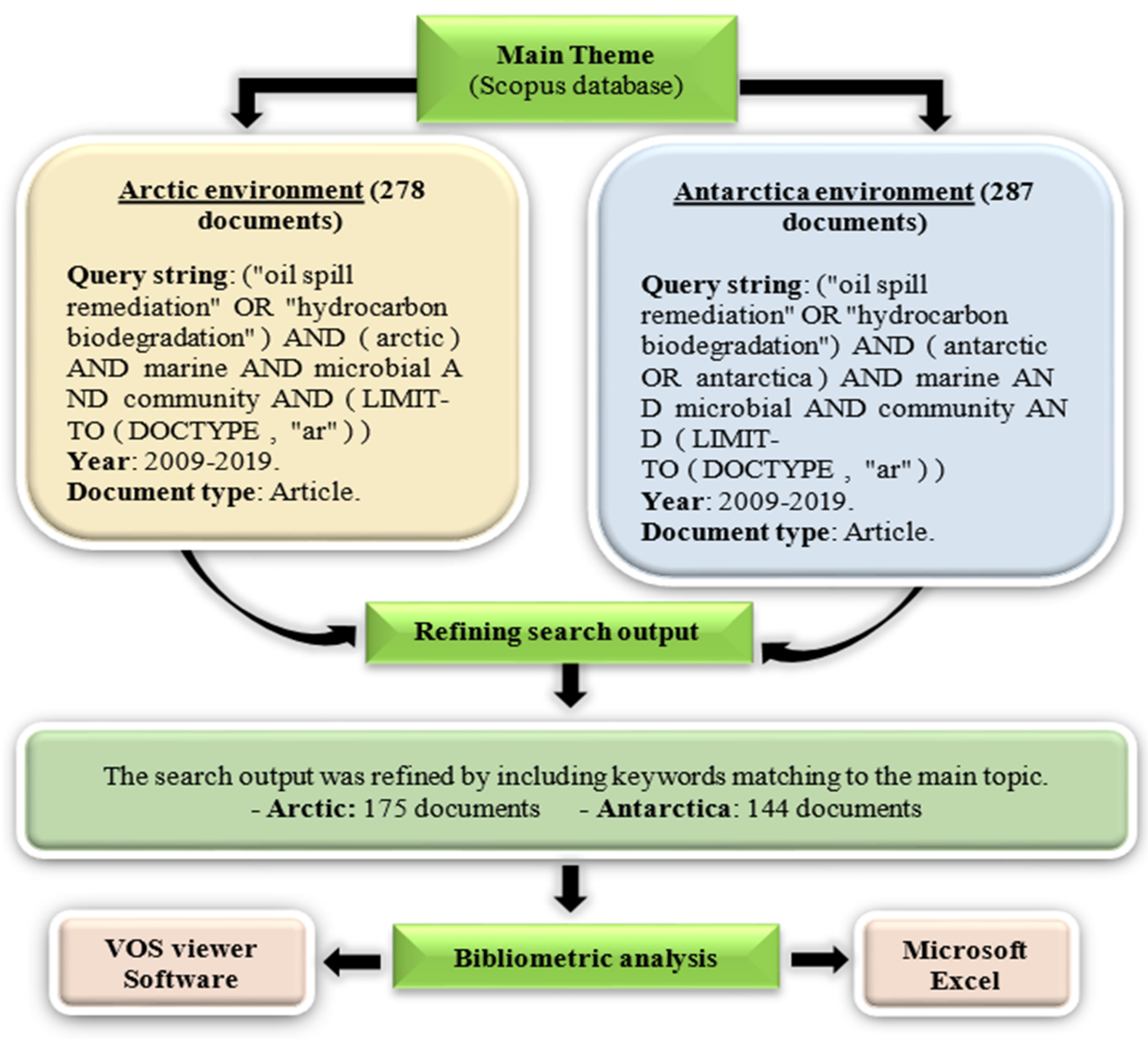
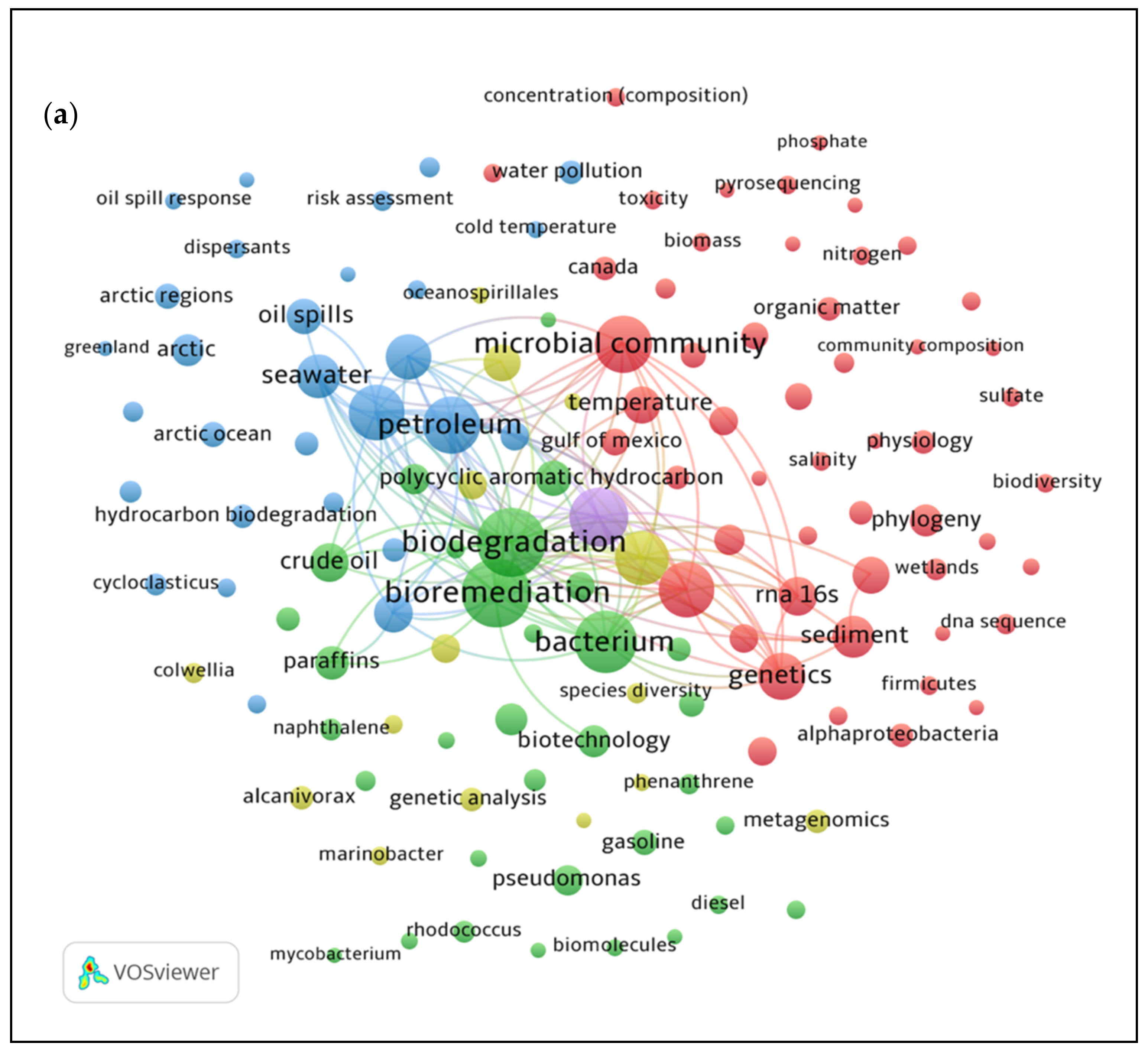

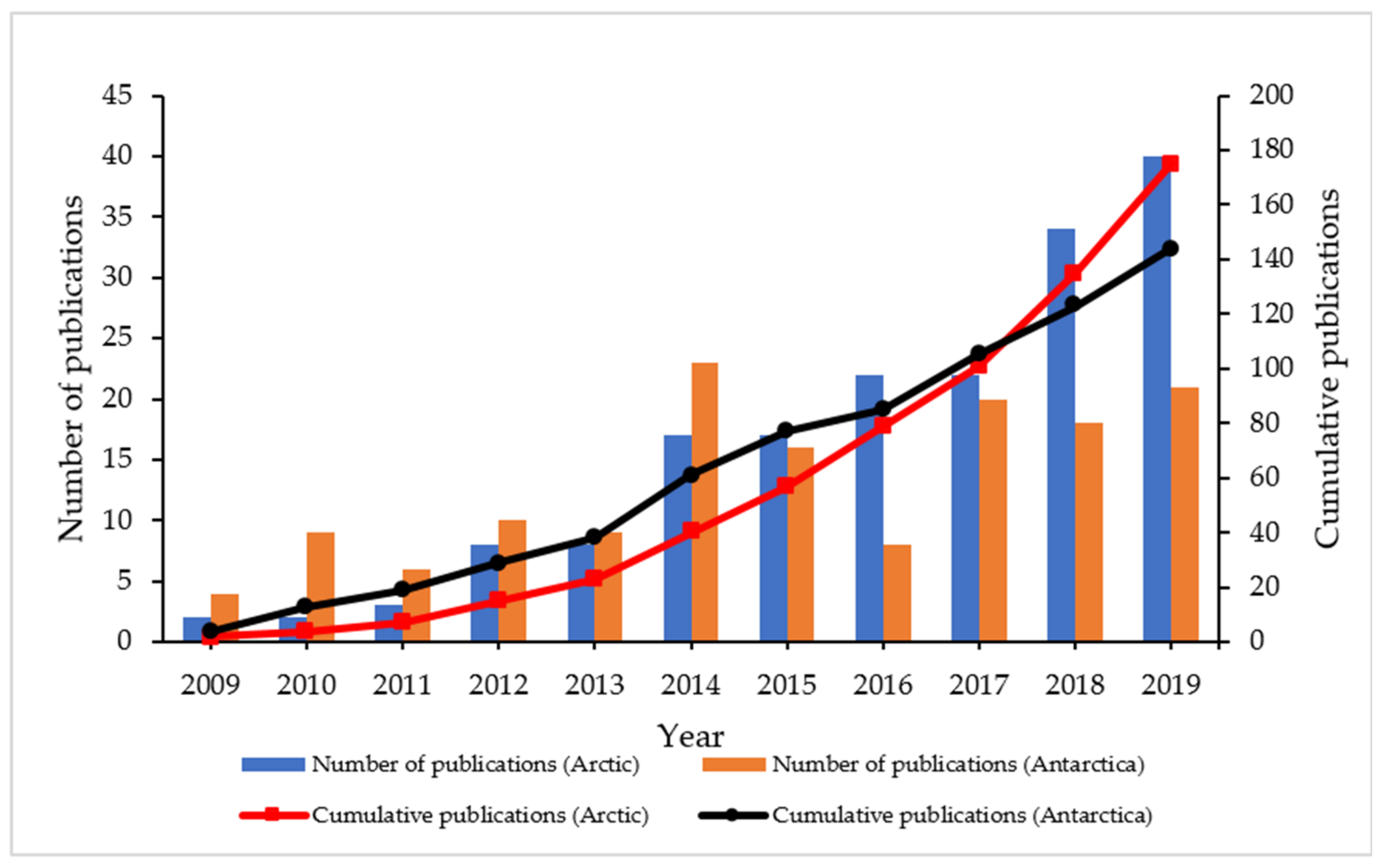
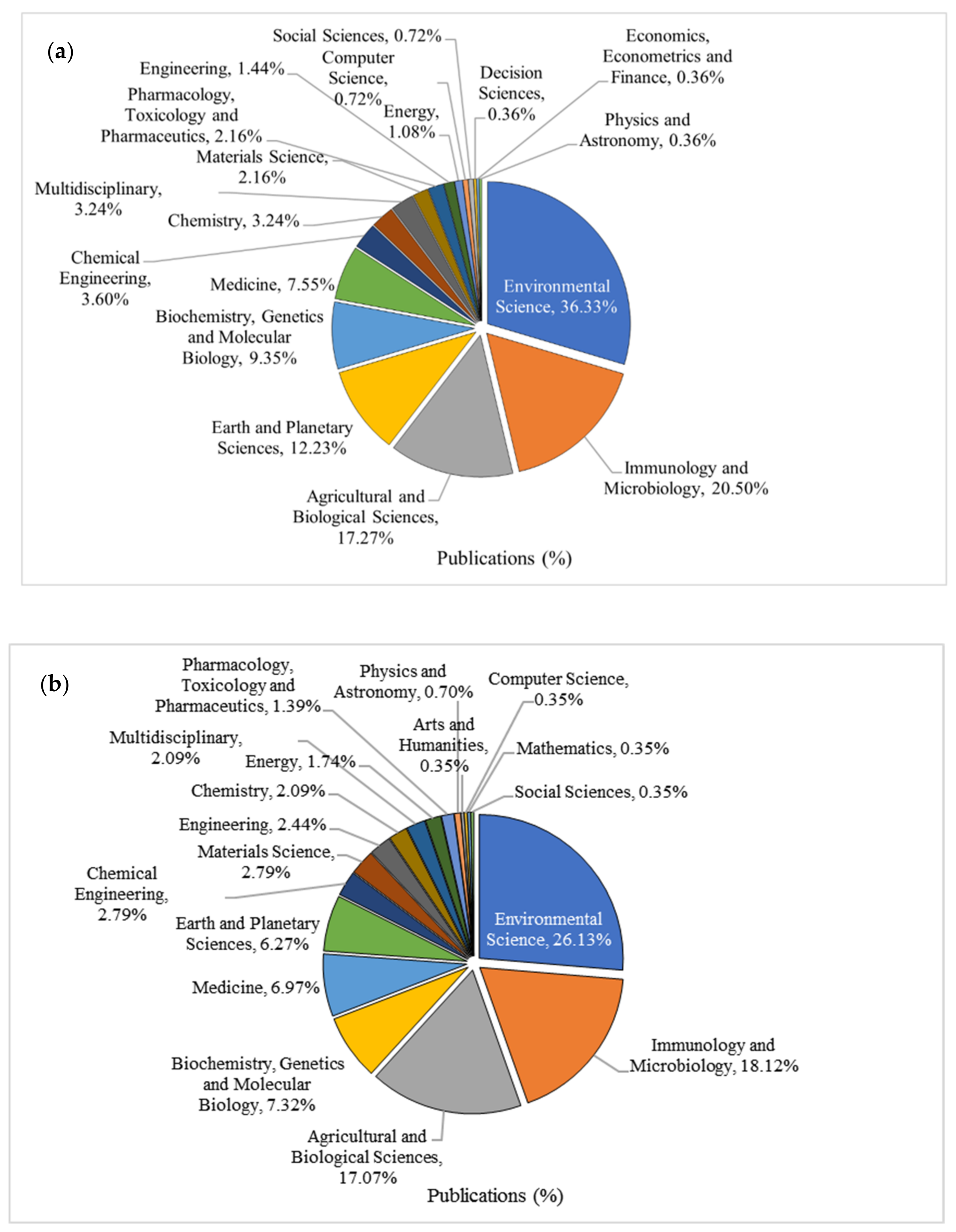
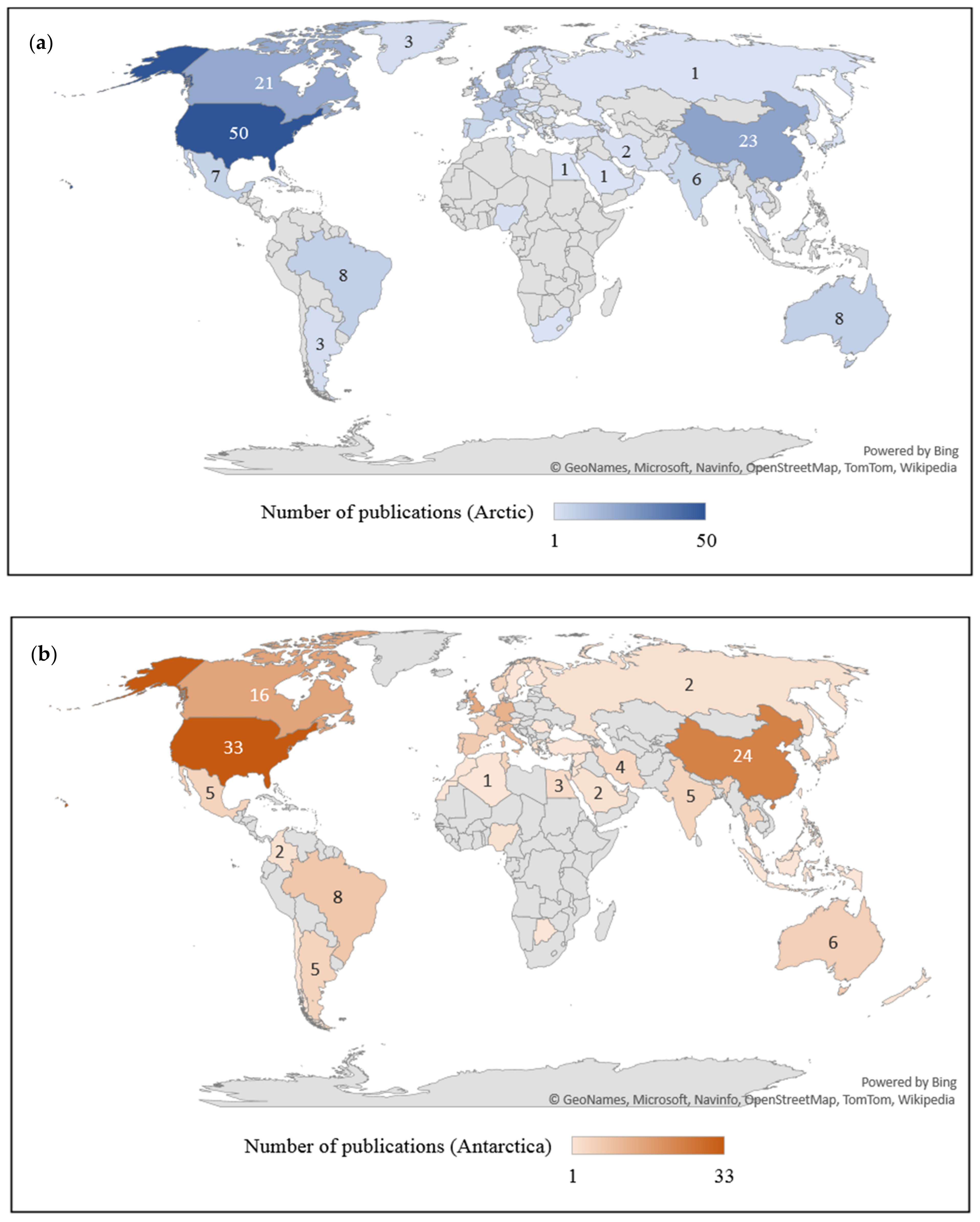
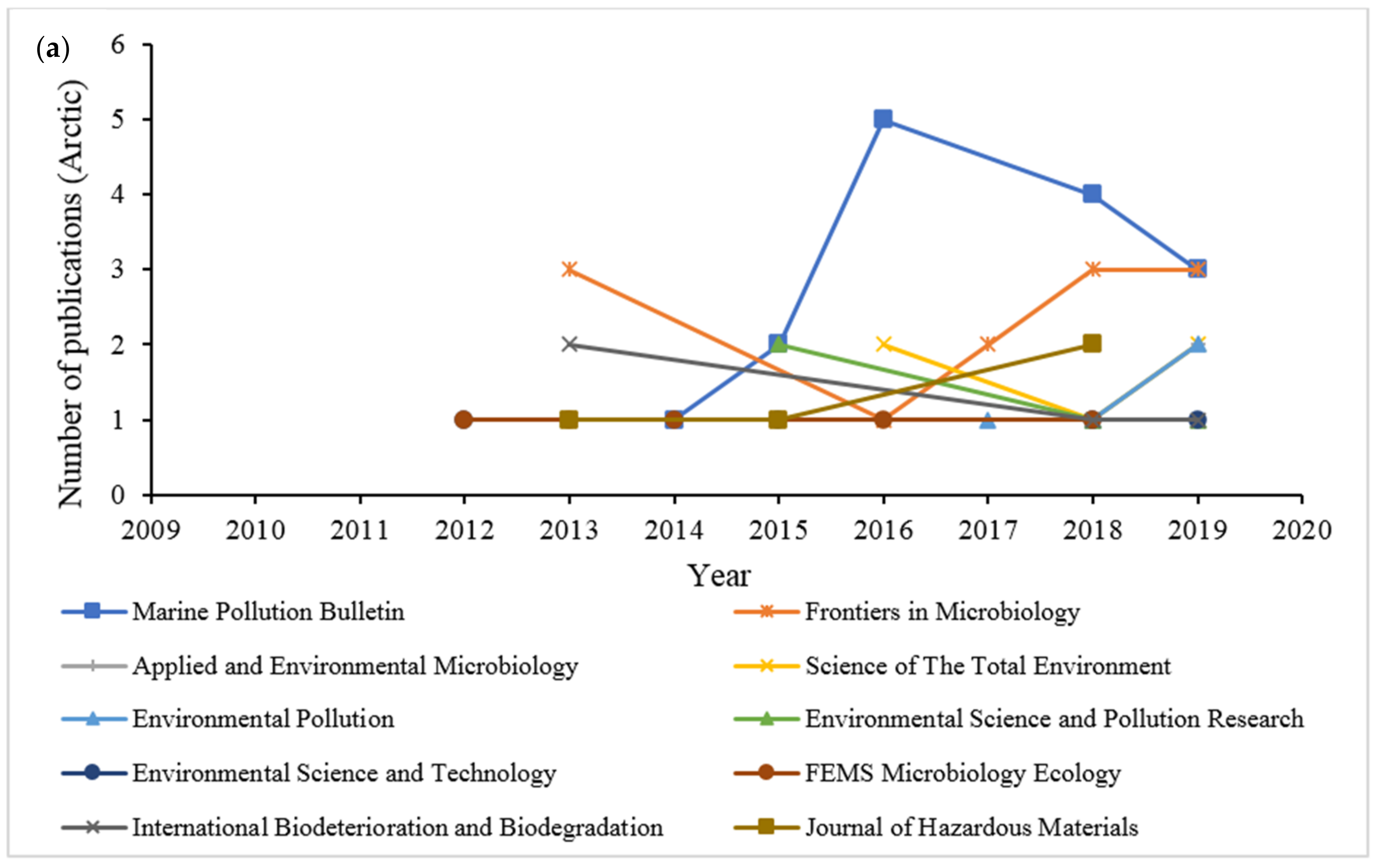

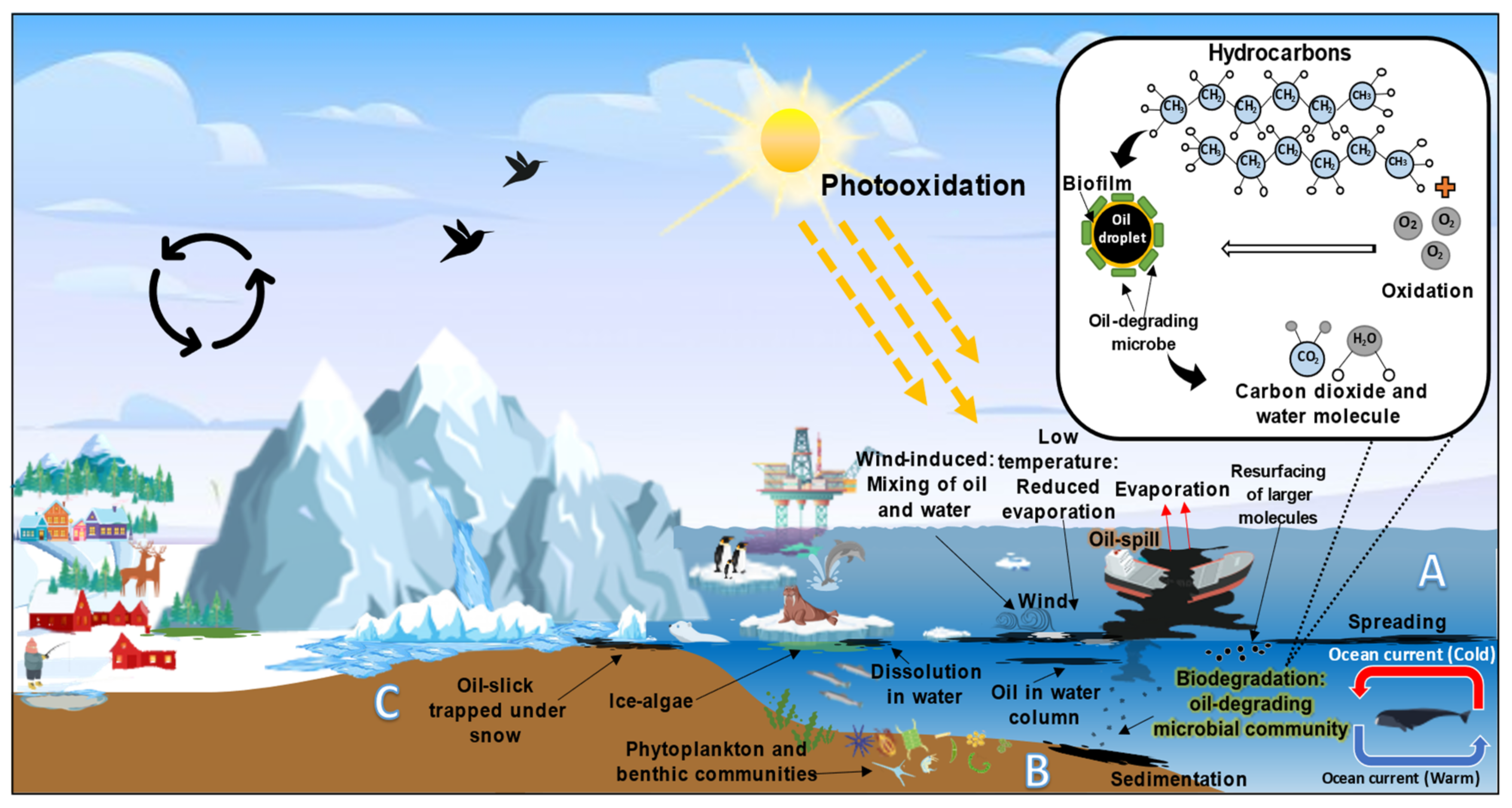
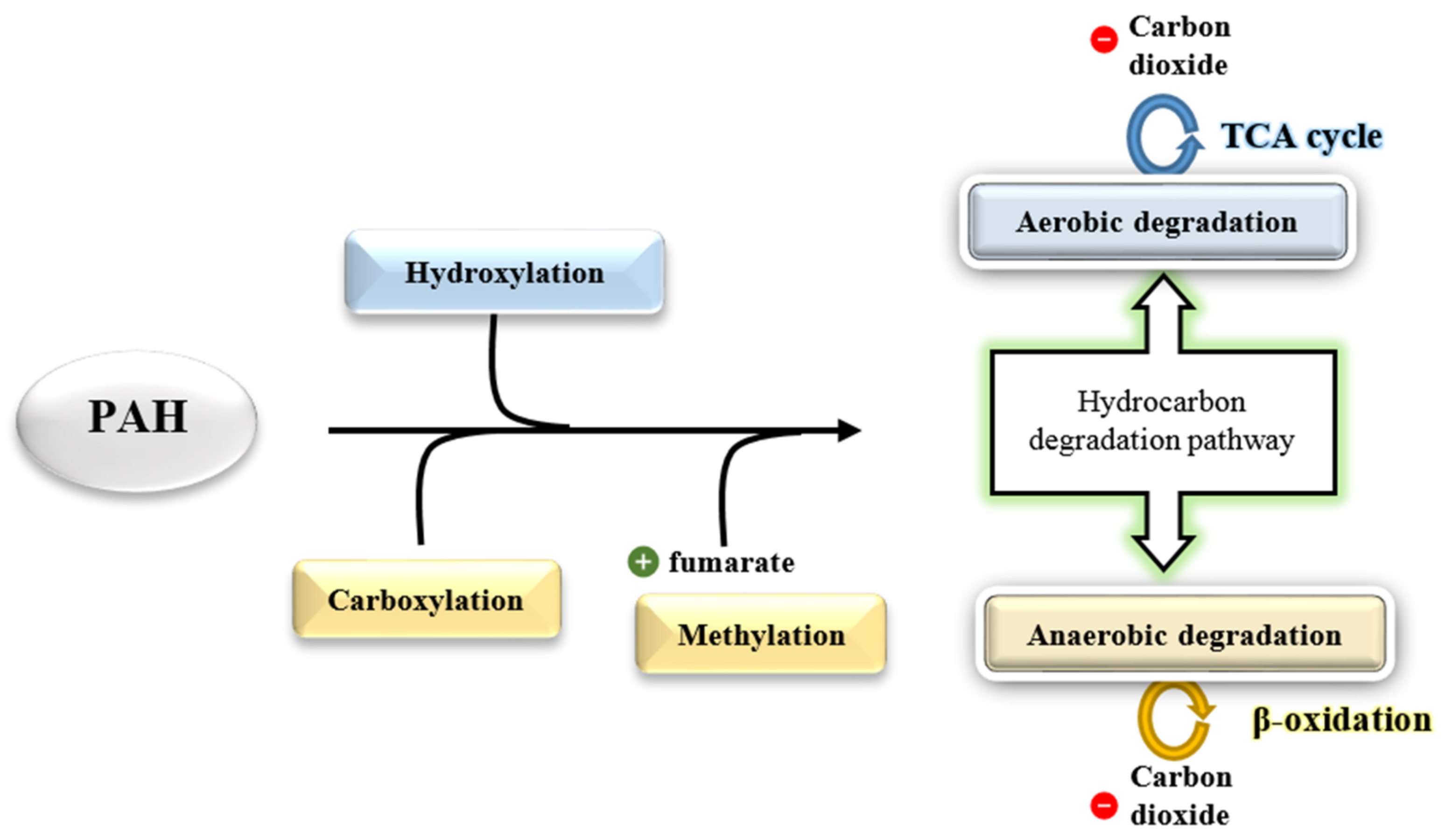
| Regions | Rank | Affiliations | Number of Publications | Country | TP by Affiliations |
|---|---|---|---|---|---|
| 1 | Chinese Academy of Sciences | 8 | China | 752,710 | |
| 2 | SINTEF Ocean | 8 | Norway | 1892 | |
| 3 | Lawrence Berkeley National Laboratory | 7 | United States | 87,396 | |
| 4 | Fisheries and Oceans Canada | 7 | Canada | 13,334 | |
| 5 | Norges Teknisk-Naturvitenskapelige Universitet | 7 | Norway | 75,976 | |
| Artic | 6 | Consiglio Nazionale delle Ricerche | 7 | Italy | 202,399 |
| 7 | Istituto per l’Ambiente Marino Costiero del Consiglio Nazionale delle Ricerche IAMC-CNR | 6 | Italy | 1573 | |
| 8 | National Research Council Canada | 5 | Canada | 57,233 | |
| 9 | The University of Tennessee, Knoxvill | 5 | United States | 72,041 | |
| 10 | University of Aberdeen | 5 | United Kingdom | 55,006 | |
| 1 | Istituto per l’Ambiente Marino Costiero del Consiglio Nazionale delle Ricerche IAMC-CNR | 8 | Italy | 1573 | |
| 2 | Consiglio Nazionale delle Ricerche | 7 | Italy | 202,399 | |
| 3 | Chung-Ang University | 6 | South Korea | 23,620 | |
| 4 | Chinese Academy of Sciences | 6 | China | 752,710 | |
| 5 | Universidade de Aveiro | 5 | Portugal | 35,047 | |
| Antarctica | 6 | University of Essex | 4 | United Kingdom | 24,631 |
| 7 | Sorbonne Universite | 4 | France | 160,067 | |
| 8 | Ministry of Education China | 4 | China | 446,329 | |
| 9 | Consejo Nacional de Investigaciones Científicas y Técnicas | 4 | Argentina | 88,317 | |
| 10 | Cornell University | 4 | United States | 180,481 |
| Rank | Journal | TP (%) | TP | IF (2019) JCR | TC (2019) JCR | TC (2019) Scopus | Cite Score 2019 | The Most Cited Article Based on Source | Year | Cited by | Publisher |
|---|---|---|---|---|---|---|---|---|---|---|---|
| 1 | Marine Pollution Bulletin | 8.57% | 15 | 4.049 | 7000 | 21,687 | 6.7 | Biodegradation of marine crude oil pollution using a salt-tolerant bacterial consortium isolated from Bohai Bay, China | 2016 | 34 | Elsevier Inc. |
| 2 | Frontiers in Microbiology | 6.86% | 12 | 4.236 | 24,092 | 65,387 | 6.4 | The microbial nitrogen cycling potential is impacted by polyaromatic hydrocarbon pollution of marine sediments | 2014 | 43 | Frontiers Research Foundation |
| 3 | Applied and Environmental Microbiology | 2.86% | 5 | 4.016 | 4761 | 17,047 | 7.1 | Corexit 9500 enhances oil biodegradation and changes active bacterial community structure of oil enriched microcosms | 2017 | 41 | American Society for Microbiology. |
| 4 | Science of the Total Environment | 2.86% | 5 | 6.551 | 45,650 | 133,587 | 8.6 | Biodegradation of dispersed Macondo crude oil by indigenous Gulf of Mexico microbial communities | 2016 | 41 | Elsevier B.V. |
| 5 | Environmental Pollution | 2.29% | 4 | 6.793 | 17,416 | 47,665 | 9.3 | Metagenome enrichment approach used for selection of oil-degrading bacteria consortia for drill cutting residue bioremediation | 2018 | 20 | Elsevier Ltd. |
| 6 | Environmental Science and Pollution Research | 2.29% | 4 | 3.056 | 17,158 | 53,503 | 4.9 | Dynamics and distribution of bacterial and archaeal communities in oil-contaminated temperate coastal mudflat mesocosms | 2015 | 23 | Springer Verlag |
| 7 | Environmental Science and Technology | 2.29% | 4 | 7.864 | 23,827 | 75,022 | 12.6 | Oil spill dispersants: Boon or bane? | 2015 | 105 | American Chemical Society |
| 8 | FEMS Microbiology Ecology | 2.29% | 4 | 3.675 | 1540 | 5623 | 6.5 | Hydrocarbon biodegradation by Arctic sea-ice and sub-ice microbial communities during microcosm experiments, Northwest Passage (Nunavut, Canada) | 2016 | 32 | Oxford University Press |
| 9 | International Biodeterioration and Biodegradation | 2.29% | 4 | 4.074 | 2208 | 7993 | 7.9 | Exploring the potential of halophilic bacteria from oil terminal environments for biosurfactant production and hydrocarbon degradation under high-salinity conditions | 2018 | 28 | Elsevier Ltd. |
| 10 | Journal of Hazardous Materials | 2.29% | 4 | 9.038 | 15,501 | 49,867 | 13.1 | Intrinsic rates of petroleum hydrocarbon biodegradation in Gulf of Mexico intertidal sandy sediments and its enhancement by organic substrates | 2013 | 32 | Elsevier B.V. |
| Rank | Journal | TP (%) | TP | IF (2019) JCR | TC (2019) JCR | TC (2019) Scopus | Cite Score 2019 | The Most Cited Article Based on Source | Year | Cited by | Publisher |
|---|---|---|---|---|---|---|---|---|---|---|---|
| 1 | Frontiers in Microbiology | 8.33% | 12 | 4.236 | 24,092 | 65,387 | 6.4 | Dynamics of bacterial communities in two unpolluted soils after spiking with phenanthrene: Soil type specific and common responders | 2012 | 60 | Frontiers Research Foundation |
| 2 | Marine Pollution Bulletin | 7.64% | 11 | 4.049 | 7000 | 21,687 | 6.7 | Rhamnolipids enhance marine oil spill bioremediation in laboratory system | 2013 | 40 | Elsevier Ltd. |
| 3 | International Biodeterioration and Biodegradation | 4.86% | 7 | 4.074 | 2208 | 7993 | 7.9 | Characterization of an alkane-degrading methanogenic enrichment culture from production water of an oil reservoir after 274 days of incubation | 2011 | 80 | Elsevier Ltd. |
| 4 | Environmental Science and Pollution Research | 3.47% | 5 | 3.056 | 17,158 | 53,503 | 4.9 | The effect of oil spills on the bacterial diversity and catabolic function in coastal sediments: a case study on the Prestige oil spill | 2015 | 41 | Springer Verlag |
| 5 | Applied and Environmental Microbiology | 2.78% | 4 | 4.016 | 4761 | 17,047 | 7.1 | Bacterial communities from shoreline environments (Costa da Morte, northwestern Spain) affected by the Prestige oil spill | 2019 | 104 | American Society for Microbiology |
| 6 | Journal of Hazardous Materials | 2.78% | 4 | 9.038 | 15,501 | 49,867 | 13.1 | Recent development in the treatment of oily sludge from petroleum industry: A review | 2013 | 473 | Elsevier B.V. |
| 7 | Microbial Ecology | 2.78% | 4 | 3.356 | 1208 | 4531 | 6.4 | Alkane biodegradation genes from chronically polluted subantarctic coastal sediments and their shifts in response to oil exposure | 2012 | 37 | Springer Science |
| 8 | Environmental Microbiology | 2.08% | 3 | 4.933 | 3320 | 12,859 | 9.1 | New alk genes detected in Antarctic marine sediments | 2009 | 49 | Society for Applied Microbiology |
| 9 | Scientific Reports | 2.08% | 3 | 3.998 | 167,821 | 596,638 | 7.2 | Bacterial population and biodegradation potential in chronically crude oil-contaminated marine sediments are strongly linked to temperature | 2015 | 54 | Nature Publishing Group |
| 10 | Annals of Microbiology | 1.39% | 2 | 1.528 | 249 | 1262 | 2.9 | Mangrove sediment, a new source of potential biosurfactant-producing bacteria | 2012 | 18 | Springer-Verlag and the University of Milan. |
| Rank | Author (1st)/Scopus ID | Current Affiliations | h-Index | TP | TC | CPP | Highest Cited Document | Journal | Cited by |
|---|---|---|---|---|---|---|---|---|---|
| 1 | Brakstad, O.G. (6602165118) | SINTEF Ocean, Trondheim, Norway | 22 | 78 | 2228 | 28.56 | Estimation of hydrocarbon biodegradation rates in marine environments: A critical review of the Q10 approach (2013 b) | Marine Environmental Research | 31 |
| 2 | Netzer, R. (7004615603) | SINTEF Ocean, Trondheim, Norway | 15 | 30 | 510 | 17.00 | Microbial community and metagenome dynamics during biodegradation of dispersed oil reveals potential key-players in cold Norwegian seawater (2018 c) | Marine Pollution Bulletin | 16 |
| 3 | Anderson, J.A. (35465962200) | University of Aberdeen, Aberdeen, United Kingdom | 50 | 235 | 7887 | 33.56 | The variable influence of dispersant on degradation of oil hydrocarbons in subarctic deep-sea sediments at low temperatures (0–5 °C) (2017 b) | Scientific Reports | 19 |
| 4 | Christensen, J.H. (7402503070) | Københavns Universitet, Copenhagen, Denmark | 28 | 117 | 2507 | 21.43 | Marine biodegradation of crude oil in temperate and Arctic water samples (2015 c) | Journal of Hazardous Materials | 20 |
| 5 | Greer, C. W. (7103169832) | National Research Council Canada, Ottawa ON, Canada | 53 | 203 | 8652 | 42.62 | Predictable bacterial composition and hydrocarbon degradation in Arctic soils following diesel and nutrient disturbance (2013 b) | ISME Journal | 122 |
| 6 | Hazen, T.C. (7006945153) | The University of Tennessee, Knoxville, Knoxville, United States | 55 | 256 | 11,597 | 45.30 | Microbial community analysis of a coastal salt marsh affected by the Deepwater Horizon oil spill (2012 b) | PLoS ONE | 132 |
| 7 | King, T.L. (7403270918) | Bedford Institute of Oceanography, Fisheries and Oceans Canada, Dartmouth, Canada | 25 | 93 | 1621 | 17.43 | Hydrocarbon biodegradation by Arctic sea-ice and sub-ice microbial communities during microcosm experiments, Northwest Passage (Nunavut, Canada) (2016 b) | FEMS Microbiology Ecology | 32 |
| 8 | Ribicic, D. (55597487500) | SINTEF Ocean, Trondheim, Norway | 8 | 15 | 160 | 10.67 | Microbial community and metagenome dynamics during biodegradation of dispersed oil reveals potential key-players in cold Norwegian seawater (2018 a) | Marine Pollution Bulletin | 16 |
| 9 | Witte, U. F. M. (7003914924) | University of Aberdeen, Aberdeen, United Kingdom | 30 | 85 | 4438 | 52.212 | The variable influence of dispersant on degradation of oil hydrocarbons in subarctic deep-sea sediments at low temperatures (0–5 °C) (2017 c) | Scientific Reports | 19 |
| 10 | Andersen, G. L. (7202552651) | Lawrence Berkeley National Laboratory, Berkeley, United States | 61 | 158 | 30,246 | 191.43 | Microbial community analysis of a coastal salt marsh affected by the Deepwater Horizon oil spill (2012 b) | PLoS ONE | 133 |
| Rank | Author (1st)/Scopus ID | Current Affiliations | h-Index | TP | TC | CPP | Highest Cited Document | Journal | Cited by |
|---|---|---|---|---|---|---|---|---|---|
| 1 | Cappello, S. (35602948000) | Consiglio Nazionale delle Ricerche, Rome, Italy | 25 | 72 | 1888 | 26.22 | Bioremediation (bioaugmentation/biostimulation) trials of oil polluted seawater: A mesocosm simulation study (2014 c) | Marine Environmental Research | 62 |
| 2 | Jeon, C.O. (24401297600) | Chung-Ang University, Seoul, South Korea | 49 | 372 | 8635 | 23.21 | Comparative genomics reveals adaptation by Alteromonas sp. SN2 to marine tidal-flat conditions: Cold tolerance and aromatic hydrocarbon metabolism (2012 c) | PLoS ONE | 55 |
| 3 | Madsen, E.L. (71018820930 | Cornell University, Ithaca, United States | 42 | 111 | 6180 | 55.68 | The genome of Polaromonas naphthalenivorans strain CJ2, isolated from coal tar-contaminated sediment, reveals physiological and metabolic versatility and evolution through extensive horizontal gene transfer (2009 c) | Environmental Microbiology | 58 |
| 4 | Almeida, A. P. (7202913857) | Universidade de Aveiro, Aveiro, Portugal | 40 | 229 | 5433 | 23.72 | Hydrocarbon contamination and plant species determine the phylogenetic and functional diversity of endophytic degrading bacteria (2014 b) | Molecular Ecology | 37 |
| 5 | Cleary, D.F.R. (7005552581) | Universidade de Aveiro, Aveiro, Portugal | 34 | 129 | 2918 | 22.62 | Unraveling the interactive effects of climate change and oil contamination on laboratory-simulated estuarine benthic communities (2015 b) | Global Change Biology | 20 |
| 6 | Cunha, A. (57210164924) | Universidade de Aveiro, Aveiro, Portugal | 37 | 147 | 4118 | 28.01 | Hydrocarbon contamination and plant species determine the phylogenetic and functional diversity of endophytic degrading bacteria (2014 c) | Molecular Ecology | 37 |
| 7 | Dellagnezze, B.M. (36542157500) | Universidade Estadual de Campinas, Campinas, Brazil | 7 | 12 | 167 | 13.92 | Bioremediation potential of microorganisms derived from petroleum reservoirs (2014 a) | Marine Pollution Bulletin | 39 |
| 8 | Denaro, R. (56072581500) | Istituto di Ricerca sulle Acque, Italy, Monterotondo, Italy | 18 | 39 | 1307 | 33.51 | Bacterial population and biodegradation potential in chronically crude oil-contaminated marine sediments are strongly linked to temperature (2015 b) | Scientific Reports | 54 |
| 9 | Dionisi, H.M. (6603560555) | Centro Para el Estudio de Sistemas Marinos (CESIMAR), CONICET-CENPAT, Puerto Madryn, | 17 | 42 | 1984 | 47.24 | Alkane biodegradation genes from chronically polluted subantarctic coastal sediments and their shifts in response to oil exposure (2012 b) | Microbial Ecology | 37 |
| 10 | Gieg, L.M. (6601913918) | University of Calgary, Calgary, Canada | 29 | 63 | 2583 | 41.00 | Subsurface cycling of nitrogen and anaerobic aromatic hydrocarbon biodegradation revealed by nucleic acid and metabolic biomarkers (2010 b) | Applied and Environmental Microbiology | 29 |
| Oil Spill Incident | Date | Source of Spill | Incident Site & Country | Type of Oil | Spill Amount (Gallon) | Clean Up Process |
|---|---|---|---|---|---|---|
| Trans Mountain oil spill [38] | 14 June 2020 | Pipeline | Abbotsford, British Columbia, Canada | Crude oil | 50,000 | Containment and remediation |
| Norilsk diesel fuel spill [39] | 29 May 2020 | Fuel storage tank | Krasnoyarsk Krai, Norilsk, Russia | Diesel fuel | 5,440,000 | Booms and pump |
| Tanker truck rollover [40] | 21 March 2020 | Tanker | Cuyaman River, Santa Maria, United States | Crude oil | 4000 | Dirt berm, absorbent pads, boom |
| Keystone Pipeline 2019 spill [41] | 29 October 2019 | Pipeline | North Dakota, Walsh County, United States | Crude oil | 383,000 | Backhoes and vacuum trucks |
| SeaRose FPSO production ship spill [42] | 16 November 2018 | Vessel flowline | Newfoundland and Labrador, St. John’s Canada | Crude oil | 66,000 | Monitoring on seabirds |
| ConocoPhillips, Canada pipeline spill [43] | 9 June 2016 | Pipeline | Grande Cache, Alberta, Canada | Light petroleum | 100,000 | Containment |
| Type of Hydrocarbon | Microbial Species/Classes | Removal Efficiency | Location | References |
|---|---|---|---|---|
| Arabian light crude oil and PAHs | Sphingopyxis Flavimaris Pseudoalteromonas Marinobacter antarcticus | 17.25–81.98% | Kongsfjorden, Svalbard Islands, Arctic region | [74] |
| Aromatic (Crude oil) | Magnetospirillum magnetotacticum | 95–99% (shorter hydrocarbon chains) | Glacial open fjord Kongsfjorden, at the Research Village in Ny-Alesund; Svalbard Archipelago, Arctic Norway | [81,82,83] |
| Sediminicola luteus | ||||
| Microbulbifer pacificus | ||||
| Sphingopyxis flavimaris | ||||
| Thiobacillus thioparus | ||||
| Aromatic (Diesel oil) | Cycloclasticus pugetii | 75% (longer hydrocarbon chains) | ||
| Novosphingobium nitrogenifigens | ||||
| Pibocella ponti | ||||
| Magnetospirillum gryphiswaldense | ||||
| PAHs | Cycloclasticusa Pseudomonasa | No information | Contaminated sediments, Makarov Basin, Arctic | [92] |
| Crude oil | Alcanivorax borkumensis | No information | Barents Sea (Russia) | [93] |
Publisher’s Note: MDPI stays neutral with regard to jurisdictional claims in published maps and institutional affiliations. |
© 2021 by the authors. Licensee MDPI, Basel, Switzerland. This article is an open access article distributed under the terms and conditions of the Creative Commons Attribution (CC BY) license (http://creativecommons.org/licenses/by/4.0/).
Share and Cite
Verasoundarapandian, G.; Wong, C.-Y.; Shaharuddin, N.A.; Gomez-Fuentes, C.; Zulkharnain, A.; Ahmad, S.A. A Review and Bibliometric Analysis on Applications of Microbial Degradation of Hydrocarbon Contaminants in Arctic Marine Environment at Metagenomic and Enzymatic Levels. Int. J. Environ. Res. Public Health 2021, 18, 1671. https://doi.org/10.3390/ijerph18041671
Verasoundarapandian G, Wong C-Y, Shaharuddin NA, Gomez-Fuentes C, Zulkharnain A, Ahmad SA. A Review and Bibliometric Analysis on Applications of Microbial Degradation of Hydrocarbon Contaminants in Arctic Marine Environment at Metagenomic and Enzymatic Levels. International Journal of Environmental Research and Public Health. 2021; 18(4):1671. https://doi.org/10.3390/ijerph18041671
Chicago/Turabian StyleVerasoundarapandian, Gayathiri, Chiew-Yen Wong, Noor Azmi Shaharuddin, Claudio Gomez-Fuentes, Azham Zulkharnain, and Siti Aqlima Ahmad. 2021. "A Review and Bibliometric Analysis on Applications of Microbial Degradation of Hydrocarbon Contaminants in Arctic Marine Environment at Metagenomic and Enzymatic Levels" International Journal of Environmental Research and Public Health 18, no. 4: 1671. https://doi.org/10.3390/ijerph18041671
APA StyleVerasoundarapandian, G., Wong, C.-Y., Shaharuddin, N. A., Gomez-Fuentes, C., Zulkharnain, A., & Ahmad, S. A. (2021). A Review and Bibliometric Analysis on Applications of Microbial Degradation of Hydrocarbon Contaminants in Arctic Marine Environment at Metagenomic and Enzymatic Levels. International Journal of Environmental Research and Public Health, 18(4), 1671. https://doi.org/10.3390/ijerph18041671








